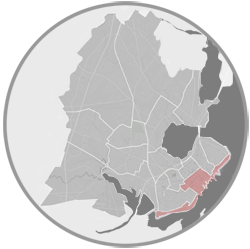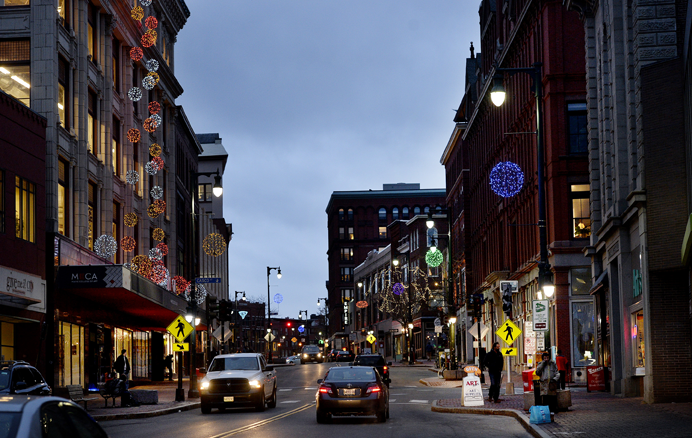DOWNTOWN
The city’s business and cultural center is also one of the most desirable residential neighborhoods.
 When Steve DiMillo Sr. started helping out at his father’s restaurant on Commercial Street in 1964, the smattering of apartments around the Old Port looked far different than the housing there today.
When Steve DiMillo Sr. started helping out at his father’s restaurant on Commercial Street in 1964, the smattering of apartments around the Old Port looked far different than the housing there today.
Young people, many of them artists without children, occupied units in tenement-style buildings.
“They were not up to date. They were low-rent,” Dimillo said. “One of the apartments housed the clubhouse or downtown location for the Iron Horsemen, which was a motorcycle gang.”
Today, the Old Port has become a symbol of the city’s surge in demand for urban housing. Locals and newcomers compete to live close to the myriad shops, restaurants and bars that have helped shape Portland’s burgeoning reputation as a sought-after place to live.
Stretching along the waterfront from the Portland Co. complex to the Sprague Terminal, and bound inland by High Street, Cumberland Avenue and Market Street, the Downtown neighborhood can be divided into two parts: The Old Port and Commercial Street area, and the Congress Street corridor just up the hill from the waterfront.
While it is home to about 2,800 people, the Downtown neighborhood also serves as a business center for Portland and for the state, heavily populated by a variety of non-tourism businesses. It also is a cultural center for the region, with the state’s largest public library, sports arena and art museum, among other attractions.

And tucked amid all of the businesses and cultural attracts are about 2,000 housing units.
Statistically, the Old Port and Downtown areas are the definition of a super-heated rental economy.
Nearly everyone who lives in the neighborhood – 93 percent – rent their living space, compared with the citywide rental rate of 55 percent. The average rent for a two-bedroom apartment is second-highest of all the city’s neighborhoods, at $1,814 – about $1,000 more than what’s considered to be affordable for Portland’s typical renter household.
Walkable and filled with tourists during the summer months, the Old Port’s charm, retail offerings and trendy food spots are wedged cheek-to-jowl. But it has not always been so.
For decades, the epicenter of retail and foot traffic was centered on Congress Street, where independent department stores thrived.
“I think what's happening now, which is really exciting, is there's all these ranges of uses that add to the urban fabric in meaningful ways.”
That dynamic dramatically faded after 1971, when the Maine Mall opened in South Portland. For the next 20 years, the Downtown would be emptied of the large-scale stores that drew shoppers as businesses filled the new mall spaces. The last department store, Porteous, Mitchell and Braun, closed in the early 1990s, a low point for a Congress Street area that had seen an increasing number of vacant storefronts.
Commercial Street’s evolution began in earnest in the 1980s, with the construction of the Chandler’s Wharf condominium project, the first upscale waterfront residential building of its kind.
That project prompted a visceral reaction among city leaders and advocates for the working waterfront, who won a citywide vote to prohibit non-marine uses on the first floor of wharf space, and a prohibition on residential condos that is still in effect today.

But those restrictions were loosened somewhat in 2010, and today, the waterfront and Commercial Street have become targets of major development efforts, including the planned redevelopment of the Portland Co. complex.
“We are in this stage of accelerating from a big town to a small city,” said Tim Soley, principal at East Brown Cow Management Inc., a longtime commercial developer who has worked extensively in the Old Port.
“I think what’s happening now, which is really exciting,” Soley said, “is there’s all these ranges of uses that add to the urban fabric in meaningful ways – people living downtown, people staying in hotels downtown, people opening shops when in the past they would exclusively go (to) South (Portland) or to Freeport.”


WHAT READERS SAY ABOUT DOWNTOWN
We asked Portlanders to describe their neighborhoods, and these are the words they used.
My neighborhood is a diverse place that's probably best known for crime. The people who live here are on welfare and drugs. Our favorite neighborhood business is Otto's and when we have spare time we like to visit the Eastern Prom for fun. Our neighborhood's best-kept secret is syringes everywhere. Andrew
My neighborhood is a busy place that's probably best known for its restaurants and the arts. The people who live here are diverse. Our favorite neighborhood business is the Public Market and when we have spare time we like to visit the Public Library for fun. Our neighborhood's best-kept secret is probably the Portland Museum of Art. Bart
My neighborhood is a sad place that's probably best known for beggars. The people who live here are clueless. Our favorite neighborhood business is begging and when we have spare time we like to visit the Public Library for fun. Our neighborhood's best-kept secret is probably the homeless. Billy
DOWNTOWN PORTLAND FROM ABOVE
A video camera mounted on an FAA approved, remote-controlled drone provides an unusual view of Portland’s rental neighborhoods.
© 2015 MaineToday Media | Originally published Dec. 29, 2015
